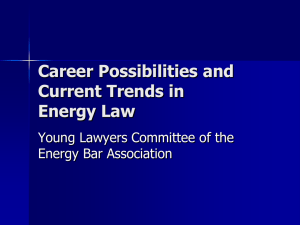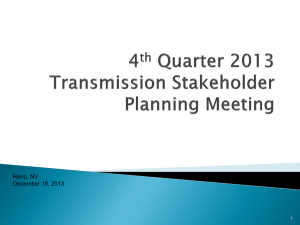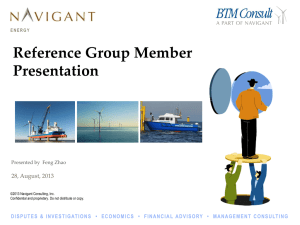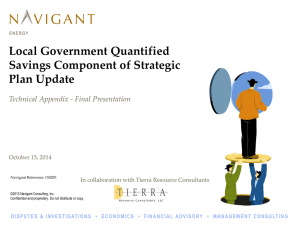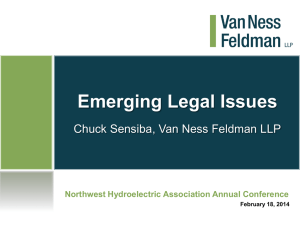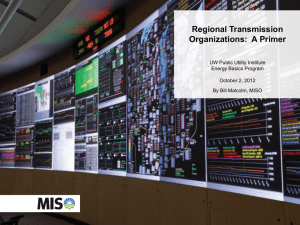Rueger-EBA-YLC-Presentation
advertisement
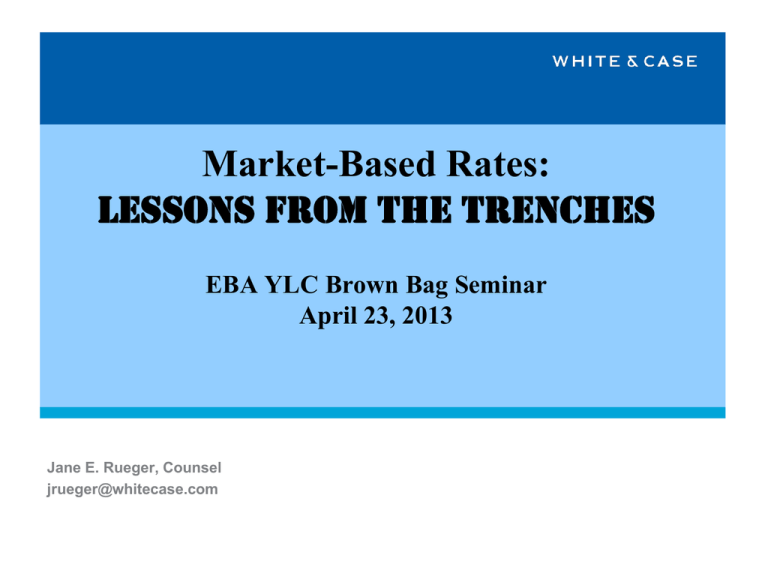
Market-Based Rates: Lessons from the Trenches EBA YLC Brown Bag Seminar April 23, 2013 Jane E. Rueger, Counsel jrueger@whitecase.com Agenda I. A Brief History The path to market-based rates (“MBR”) in the US II. MBR Application Framework Overview of FERC’s requirements for obtaining MBR Authority III. Spotlight on Market Power Presented by Julie Solomon IV. Maintaining MBR Authority Ongoing compliance obligations V. “Tips from the Trenches” VI. Q&A White & Case 1 I. A BRIEF HISTORY White & Case 2 Federal Rate Regulation Starts With The Federal Power Act Under Part II of the Federal Power Act, FERC has jurisdiction over wholesale sales of electric energy in interstate commerce and the transmission of electric energy in interstate commerce. FPA Section 205 requires that public utilities file with FERC all rates and charges subject to FERC’s jurisdiction, and such rates and charges must be “just and reasonable.” Traditionally, rates were (and many still are) cost-based, allowing a public utility to recover its cost of service plus a reasonable return on equity. In the late 1980s, FERC began to approve market-based rates for wholesale sales of electric energy in order to incentivize participation in the energy markets by non-traditional suppliers such as independent power producers and power marketers. White & Case 3 Development of FERC’s Market-Based Rate Program While the FPA does not require rates to be cost-based, FERC must exercise its oversight to ensure ex ante that market-based rates are just and reasonable when granted. Farmers Union Central Exchange, Inc. v. FERC, 734 F.2d 1486 (D.C. Cir. 1984). FERC must also engage in effective regulatory oversight after market-based rate authority is granted to ensure that market-based rates continue to be just and reasonable over time. State of California ex rel. Lockyer v. FERC, 383 F.3d 1006 (9th Cir. 2004). Order No. 697 and orders on rehearing and clarification of Order No. 697 provide the essential roadmap for FERC’s current approach to these two requirements. White & Case 4 II. MBR APPLICATION FRAMEWORK White & Case 5 Essential Components of MBR Application 1 Describe Applicant & Affiliates 2 Address Market Power 3 Address Ancillary Services, Category Status, and Other Waivers and Limitations 4 eTariff and Appendices White & Case 6 1. Describe Applicant & Affiliates Describe the applicant and the facilities it owns and controls. Describe the corporate ownership structure of the applicant Upstream holding companies Downstream subsidiaries Describe affiliates of the applicant that own or control generation facilities transmission facilities natural gas transmission, storage or distribution facilities inputs to electric power production White & Case 7 2. Address Market Power Explain how the applicant meets the legal standard … FPA § 205 a. b. Rates and charges made or received by any public utility for the sale of electric energy subject to the Commission’s jurisdiction must be “just and reasonable” and not unduly discriminatory or preferential. Applicant and affiliates do not have, or have adequately mitigated, horizontal (generation) market power. Applicant and affiliates do not have, or have adequately mitigated, vertical market power. Transmission market power Ability to erect barriers to entry in the relevant market: “Applicant affirmatively states that it has not erected barriers to entry into the relevant market and will not erect barriers to entry into the relevant market” White & Case 8 3. Address Ancillary Services, Category Status, and Other Waivers and Limitations Sellers must separately request authorization to sell ancillary services into relevant markets. Sellers must request and justify appropriate category status in each FERC designated region Category 1 sellers are defined in Section 35.36 of FERC’s regulations Sellers may request appropriate waivers and blanket authorizations Waiver of the accounting, reporting, and other requirements of Parts 41, 101, and 141 of the Commission’s regulations, with the exception of 18 C.F.R. Sections 141.14 and 141.15; Blanket authorization under Section 204 of the FPA and Part 34 of the Commission’s regulations for future issuances of securities and assumptions of liability; Waiver of the full filing requirements of subparts B and C of Part 35 of the Commission’s regulations, except the transmittal requirements of 18 C.F.R. Sections 35.12(a), 35.13(b), and the notification of succession and cancellation of service requirements of 18 C.F.R. Sections 35.15 and 35.16 Waiver of the affiliate code of conduct Sellers must notify FERC whether they will engage in the reporting of transactions to publishers of electric or natural gas prices indices. White & Case 9 4. eTariff and Appendices The MBR application including a proposed tariff must be submitted through FERC’s eTariff program Use standard tariff language for Ancillary services available for sale in each organized market and outside organized markets Statement of ongoing compliance with Part 35 Subpart H of FERC’s regulations Limitations and Waivers that have been granted to seller Seller’s Category Status in all regions Consult FERC website for guidance on standard language http://www.ferc.gov/industries/electric/gen-info/mbr.asp White & Case 10 4. eTariff and Appendices List all affiliates with MBR authority, identifying all generation assets owned or controlled by the corporate family by balancing authority area and geographic region. List all electric transmission and natural gas intrastate pipelines and/or gas storage facilities owned or controlled by the corporate family. White & Case 11 III. ADDRESSING MARKET POWER White & Case 12 FERC Market-Based Rates EBA Young Lawyers Committee April 23, 2013 ©2013 Navigant Consulting, Inc. Confidential and proprietary. Do not distribute or copy. D I S P U T E S & I N V E S T I G AT I O N S • E C O N O M I C S • F I N A N C I A L A D V I S O RY • M A N A G E M E N T C O N S U LT I N G Table of Contents 1 Measures of Market Power 2 FERC Horizontal Analysis 3 Implications ©2013 Navigant Consulting, Inc. Confidential and proprietary. Do not distribute or copy. 14 ENERGY Table of Contents 1 Measures of Market Power 2 FERC Horizontal Analysis 3 Implications ©2013 Navigant Consulting, Inc. Confidential and proprietary. Do not distribute or copy. 15 ENERGY Definition of Market Power Ability to profitably sustain an increase in the market price (through unilateral action or tacit collusion). › Horizontal Market Power. Strategic withholding (withholding some capacity to profit on capacity actually sold). › Physical withholding (taking generation out of service). › Economic withholding (bidding above expected market clearing price). › Vertical Market Power. › Control over inputs to production (e.g., transmission or natural gas transportation) to raise competitors’ costs or deny access. ©2013 Navigant Consulting, Inc. Confidential and proprietary. Do not distribute or copy. 16 ENERGY Typical Measures of Market Power Various quantitative measures are used to evaluate market power – by FERC, antitrust agencies, and market monitoring units of RTOs/ISOs › › Market Share. Market Concentration. Measured by Herfindahl-Hirschman Index (HHI). Unconcentrated, moderately concentrated, highly concentrated markets. › Pivotal Supply. Whether the supply of a single or multiple suppliers is required to meet demand. › Residual Supply Index. Percentage of demand that can be met without relying on an individual seller’s capacity. › Lerner Index or Price-Cost Markup. Price minus marginal cost divided by price. ©2013 Navigant Consulting, Inc. Confidential and proprietary. Do not distribute or copy. 17 ENERGY Table of Contents 1 Measures of Market Power 2 FERC Horizontal Analysis 3 Implications ©2013 Navigant Consulting, Inc. Confidential and proprietary. Do not distribute or copy. 18 ENERGY FERC Market-Based Rates Horizontal Analysis FERC requires analysis of horizontal market power in context of granting generators/marketers authority to sell into wholesale markets at market-based rates, for triennial reviews, and for notices of change in status › Primary analytical tool (Indicative screens) › Simplified Pivotal Supplier Analysis › Simplified Market Share Analysis › Brightline tests: not a pivotal supplier, market share less than 20% in all seasons › Secondary analytical tool (if indicative screens are failed) › Delivered Price Test › Historical Sales › No brightline tests ©2013 Navigant Consulting, Inc. Confidential and proprietary. Do not distribute or copy. 19 ENERGY FERC Indicative Screens FERC’s Indicative Screens consist of “Pivotal Supplier Analysis” and “Market Share Analysis” › Relevant Market › Balancing authority area (“BAA”) or RTO/ISO based on where generation is located › Transmission owners/operators must analyze own BAA and first-tier interconnected markets (unless relevant market is RTO/ISO › Relevant Submarket › FERC has identified relevant submarkets in certain RTOs • • • PJM: PJM East, AP South, 5004/5005 interface NYISO: New York City, Long Island ISO-NE: Southwest Connecticut, Connecticut Interface ©2013 Navigant Consulting, Inc. Confidential and proprietary. Do not distribute or copy. 20 ENERGY FERC Indicative Screens › Study Period › An historical one-year period, December-November • Updated market power analyses (triennial reviews) for transmissionowning applicants o Study period based on Order No. 697 schedule • Updated market power analyses for applicants that do not own transmission o Study period based on Order No. 697 schedule • Transmission-owning applicants for initial market-based rate authorization or submission of a change in status filing o Most recent available actual historical data • All other applicants o Same vintage data that were used in the triennial reviews filed by the transmission owners in their region within the past year; or, if not available o Most recently available actual historical data for December-November period, or o the same seasons in their market share studies that were used in the most recently filed triennial studies, with explanation ©2013 Navigant Consulting, Inc. Confidential and proprietary. Do not distribute or copy. 21 ENERGY FERC Indicative Screens › Triennial Schedule › Exemption: Category 1 sellers, less than 500 MW per region Transmission Owners Region › Others Filing Date Region Filing Date Northwest June 2013 Northwest December 2013 Northeast December 2013 Northeast June 2014 Southeast June 2014 Southeast December 2014 Central December 2014 Central June 2015 SPP June 2015 SPP December 2015 Southwest December 2015 Southwest June 2016 Change in Status Filing › Within 30 days after event › Materiality threshold: net change of 100 MW ©2013 Navigant Consulting, Inc. Confidential and proprietary. Do not distribute or copy. 22 ENERGY Indicative Screen: Pivotal Supplier Analysis ©2013 Navigant Consulting, Inc. Confidential and proprietary. Do not distribute or copy. 23 ENERGY Indicative Screen: Market Share Analysis ©2013 Navigant Consulting, Inc. Confidential and proprietary. Do not distribute or copy. 24 ENERGY Market-Based Rate Implementation Process Pass RTOs/ISOs Indicative Screens Keep MBR Authority Rely on RTO Market Monitoring and Mitigation Fail Pass Balancing Authority Areas Keep MBR Authority Pass+ Indicative Screens Fail DPT+ Fail Mitigation (Cost-based Rates) ©2013 Navigant Consulting, Inc. Confidential and proprietary. Do not distribute or copy. 25 ENERGY FERC Horizontal Analysis FERC relies on a Delivered Price Test (“DPT”) to evaluate mergers and as a secondary analysis in market-based rate proceedings where applicants fail indicative screens › Geographic Market. RTOs/ISOs or submarkets (constrained areas within RTO/ISO), or BAAs. › Product Market. Primary focus on energy (capacity), but also ancillary services where information is available. › Economic Capacity. Energy that is economic and deliverable to the market (including transmission costs and losses) at a cost within 105% of market price. Ignores native load commitments. › Available Economic Capacity. Same as Economic Capacity but takes into account native load commitments. ©2013 Navigant Consulting, Inc. Confidential and proprietary. Do not distribute or copy. 26 ENERGY FERC Horizontal Analysis (continued) › For market based rates, DPT is analyzed in the context of pivotal supplier test, market share and market concentration. Typically ten load/time period snapshots are examined. • • • Pivotal supplier (pass/fail) Market share (~20%, not bright-line test) Market concentration (<2500, also not bright-line test) › Market concentration (HHI) calculated based on market shares squared. • • 4 equal sized suppliers (25% each), HHI is 2500 (25%^2*4) 2 large suppliers (40% each), plus 4 small suppliers (5%) each, HHI is 3300 (40%^2*2+5%^2*4) ©2013 Navigant Consulting, Inc. Confidential and proprietary. Do not distribute or copy. 27 ENERGY Sample DPT Results for DPT Available Economic Capacity Period a Market Price b S_SP1 S_SP2 S_P S_OP W_SP W_P W_OP SH_SP SH_P SH_OP $ $ $ $ $ $ $ $ $ $ Applicant MW c 100 50 40 30 40 30 25 40 30 25 1,900 1,500 1,500 0 1,800 1,400 0 1,800 0 0 Mkt Size d 8,000 7,900 6,000 3,500 7,500 6,000 3,500 9,000 7,500 3,500 Pivotal Supplier Test Market Share Test Pass Pass Wholesale Pivotal Market Rival Market Supplier Mkt Share Capacity Load ? Share Test? e f g h i 6,100 6,400 4,500 3,500 5,700 4,600 3,500 7,200 7,500 3,500 6,400 6,320 4,800 2,800 6,000 4,800 2,800 7,200 6,000 2,800 Yes Yes Yes Yes Yes Yes Yes Yes Yes Yes 24% 19% 25% 0% 24% 23% 0% 20% 0% 0% No Yes No Yes No No Yes No Yes Yes Market Pass HHI Test? k HHI j 2,700 2,600 2,100 1,700 2,000 1,800 2,000 2,100 1,800 2,000 No No Yes Yes Yes Yes Yes Yes Yes Yes Wholesale market load is proxy from Indicative Screens Pivotal Supplier Test. Economic Capacity Period a Market Price b S_SP1 S_SP2 S_P S_OP W_SP W_P W_OP SH_SP SH_P SH_OP $ $ $ $ $ $ $ $ $ $ Applicant MW c 100 50 40 30 40 30 25 40 30 25 ©2013 Navigant Consulting, Inc. Confidential and proprietary. Do not distribute or copy. 1,900 1,500 1,500 0 1,900 1,500 0 1,900 0 0 Mkt Size d 14,400 14,220 10,800 8,000 13,500 10,800 8,000 16,200 13,500 8,000 Pivotal Supplier Test Market Share Test Pass Pass Wholesale Pivotal Market Rival Market Supplier Mkt Share Capacity Load ? Share Test? e f g h i 12,500 12,720 9,300 8,000 11,600 9,300 8,000 14,300 13,500 8,000 11,520 11,376 8,640 6,400 10,800 8,640 6,400 12,960 10,800 6,400 Yes Yes Yes Yes Yes Yes Yes Yes Yes Yes 13% 11% 14% 0% 14% 14% 0% 12% 0% 0% Yes Yes Yes Yes Yes Yes Yes Yes Yes Yes Market HHI j 5,000 5,000 4,500 4,800 4,400 4,000 3,000 4,000 3,900 2,500 Pass HHI Test? k No No No No No No No No No No 28 ENERGY FERC Horizontal Analysis (continued) Whether the more important measure is Economic Capacity (ignoring load obligations) or Available Economic Capacity (taking into account load obligations) depends... › In restructured markets (e.g., RTOs/ISOs) › Economic Capacity is more relevant › Utilities have largely divested generation › Utilities generally meet load obligations through contracts › In non-restructured markets › Available Economic Capacity is more relevant › Utilities remain vertically-integrated › Utilities have continuing load obligations ©2013 Navigant Consulting, Inc. Confidential and proprietary. Do not distribute or copy. 29 ENERGY Table of Contents 1 Measures of Market Power 2 FERC Horizontal Analysis 3 Implications ©2013 Navigant Consulting, Inc. Confidential and proprietary. Do not distribute or copy. 30 ENERGY Implications › Market-based Rates › FERC’s approach provides roadmap for standards to be met › RTO market mitigation and monitoring has been acceptable mitigation › Some parties are losing market-based rate authority in BAAs where they own generation › › Mostly, this affects incumbent utilities › Some results for merchant generators are unexpected Applicants can use default cost-based mitigation or propose tailored mitigation ©2013 Navigant Consulting, Inc. Confidential and proprietary. Do not distribute or copy. 31 ENERGY Key CONTACTS ENERGY Julie R. Solomon| Managing Director julie.solomon@navigant.com 202.481.8492 direct ©2010 Navigant Consulting, Inc. ©2013 Confidential and proprietary. Do not distribute or copy. 32 ENERGY IV. MAINTAINING MBR White & Case 33 Primary FERC Tools For Monitoring MBR Sellers MBR sellers must file Electric Quarterly Reports containing contract and transaction data relevant to their market-based sales, even if no sales have occurred Order Nos. 768 and 770 revised content and filing system effective 3Q 2013 MBR sellers must abide by the Market Behavior Rules codified in Part 35 of FERC’s regulations MBR sellers must file change in status notifications within 30 days of the effective date of a change “that would reflect a departure from the characteristics that FERC relied upon in granting market-based rate authority.” If Category 2, MBR sellers must make triennial market power filings reaffirming that they do not have, or have adequately mitigated, horizontal and vertical market power. MBR sellers must abide by RTO/ISO market rules designed to mitigate market power White & Case 34 4. Triennial Market Power Update Regions White & Case 35 V. SOME TIPS FROM THE TRENCHES White & Case 36 Tips from the Trenches 1. Don’t get sloppy with the MWs from partially owned affiliates. FERC has specific rules governing how to attribute MWs, and it differs between partially owned plants and partially owned affiliates. 2. Describe all affiliates in all regions. 3. If you complete the market screens using data filed by someone else, use the most recent market data on file. And, indicate whose screens you are relying upon. 4. Ask lots of questions of your clients! 5. Do not deviate from standard language for barriers to entry affirmative statement or required tariff provisions. White & Case 37 Tips from the Trenches 6. Check your asset appendices, and then check them again. Do not deviate from the form the Commission requires. 7. Project companies can be Category 1 sellers in regions where they are affiliated with over 500 MWs of generation if they do not have any MWs themselves in those regions. 8. Consider whether to seek waiver of the open access requirements with regard to interconnection facilities. 9. Change in status filings are required for net increases in generation of 100 MW or more and separately for affiliation with new generationowning entities that were not previously divulged. 10. Think through the eTariff program requirements well in advance of filing. White & Case 38 Questions? For more information: Jane Rueger, Counsel: jrueger@whitecase.com; 202-626-6534 Julie Solomon, Managing Director: julie.solomon@navigant.com; 202-481-8492 White & Case 39
